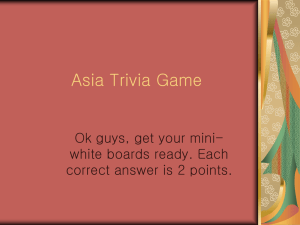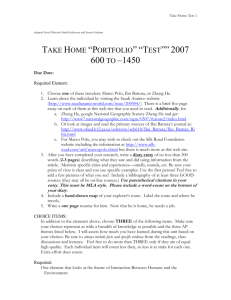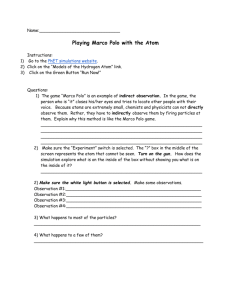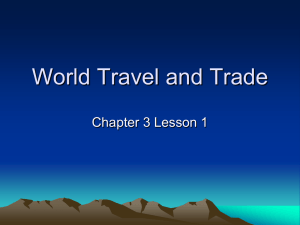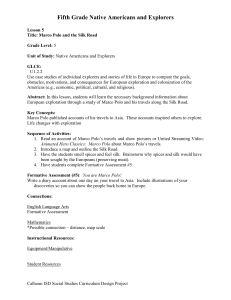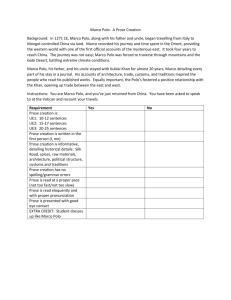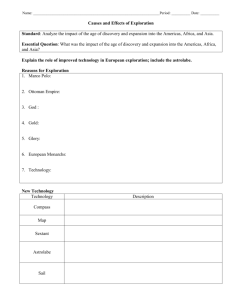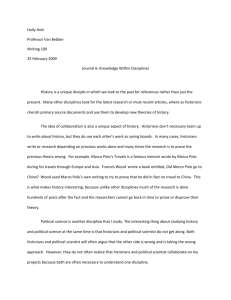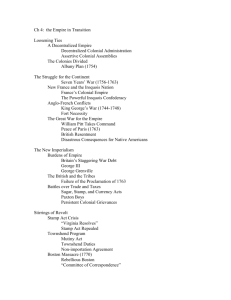Unit 12 – The Age of Exploration
advertisement
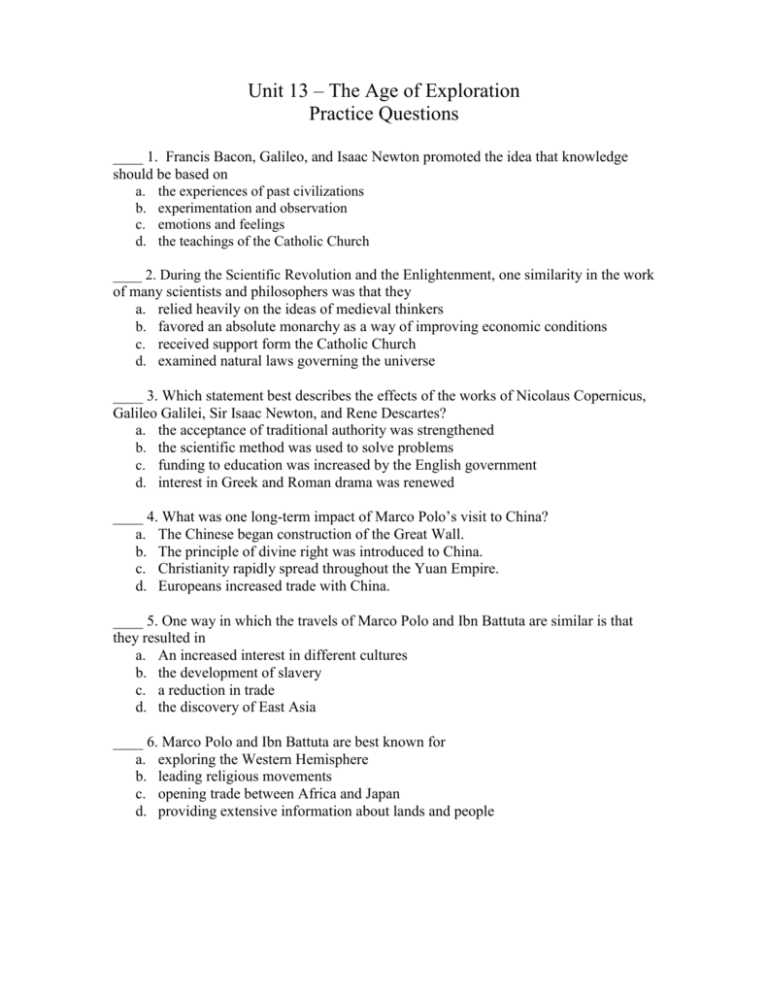
Unit 13 – The Age of Exploration Practice Questions ____ 1. Francis Bacon, Galileo, and Isaac Newton promoted the idea that knowledge should be based on a. the experiences of past civilizations b. experimentation and observation c. emotions and feelings d. the teachings of the Catholic Church ____ 2. During the Scientific Revolution and the Enlightenment, one similarity in the work of many scientists and philosophers was that they a. relied heavily on the ideas of medieval thinkers b. favored an absolute monarchy as a way of improving economic conditions c. received support form the Catholic Church d. examined natural laws governing the universe ____ 3. Which statement best describes the effects of the works of Nicolaus Copernicus, Galileo Galilei, Sir Isaac Newton, and Rene Descartes? a. the acceptance of traditional authority was strengthened b. the scientific method was used to solve problems c. funding to education was increased by the English government d. interest in Greek and Roman drama was renewed ____ 4. What was one long-term impact of Marco Polo’s visit to China? a. The Chinese began construction of the Great Wall. b. The principle of divine right was introduced to China. c. Christianity rapidly spread throughout the Yuan Empire. d. Europeans increased trade with China. ____ 5. One way in which the travels of Marco Polo and Ibn Battuta are similar is that they resulted in a. An increased interest in different cultures b. the development of slavery c. a reduction in trade d. the discovery of East Asia ____ 6. Marco Polo and Ibn Battuta are best known for a. exploring the Western Hemisphere b. leading religious movements c. opening trade between Africa and Japan d. providing extensive information about lands and people ____ 7. The travels of Marco Polo resulted in the a. introduction of gunpowder to China b. decline of Mongol rule in China c. expansion of trade between China and Europe d. use of Confucian teachings in Europe ____ 8. Historians value the writings of Marco Polo and Ibn Battuta because they a. serve as primary sources about trade and culture b. provide the basis for European holy books c. include advice on how to be a democratic ruler d. present unbiased views of life in Africa and Asia ____ 9. The astrolabe and improvements in cartography helped Europeans to a. launch the Crusades b. defeat the Mongols c. expel the Moors d. explore the Western Hemisphere ____ 10. During the 1500s, technological advances in navigation, naval engineering, and mapmaking contributed directly to the start of the a. Gupta Empire b. Age of Exploration c. Mongol Empire d. medieval guilds ___ 11. What was one reason the Spanish conquistadors were able to conquer the Aztec Empire? a. The Spanish soldiers made effective use of their military technology against the Aztecs. b. Aztec religious beliefs promoted nonviolence. c. Spain joined the Incas in their fight against the Aztecs. d. The Spanish cavalry outnumbered the Aztec warriors. ____ 12. The encomienda system in colonial Latin America led to the a. use of forced labor b. establishment of trade unions c. increase in landownership by Native Americans d. weakening of the power of peninsulares ____ 13. Which statement accurately reflects population changes that occurred as a result of the Age of Exploration? a. Most Latin American populations became more culturally diverse. b. One third of Europe’s population died due to exposure to diseases from the Americas. c. The introduction of goods from the Americas caused a decline in Asian populations. d. Native Americans migrated to Africa causing increases in African populations. ____ 14. The social class system in Latin America during the 16th and 17th centuries reflects the a. dominance of Spanish-born nobility b. emerging equality between classes c. influence of mestizo economic power d. ncreasing social mobility of Native American Indians ____ 15. Which diagram shows the correct social hierarchy of Spain’s colonial empire in the Western Hemisphere? ____ 16. Based on the information shown on this map, most manufactured goods were produced in a. the West Indies b. English colonies c. Europe d. Africa ____ 17. What is the most appropriate title for the map? a. The Industrial Revolution b. Imperialism in Africa c. The Age of Discovery d. Atlantic Trade Routes ____ 18. Which economic system was responsible for the creation of the situation shown on the map? a. feudal system b. socialism c. mercantilism d. barter system ____ 19. The Middle Passage is best defined as a. A route through the Swiss Alps b. A narrow body of water connecting two larger bodies of water c. the forced journey of enslaved Africans to the Americas d. the expulsion of Muslims from Spain ____ 20. “The purpose of colonies is to ship raw materials to the colonial power and buy finished goods from the colonial power.” This statement reflects the basic idea of which economic system? a. socialism b. mercantilism c. communism d. capitalism ____ 21. Which statement describes an impact that the Columbian Exchange had on the lives of Europeans? a. The transfer of new products and ideas encouraged economic growth. b. New diseases were brought to Europe and resulted in massive deaths caused by a plague. c. Native Americans immigrated to Europe and competed with Europeans for jobs. d. Cross-cultural contacts between South America and Asia declined. ____ 22. Which statement best describes the concept of mercantilism? a. Universal suffrage leads to educated citizens. b. Controlling trade is a key to increasing power. c. Only the fittest deserve to survive. d. Strict social control prevents revolutions. ____ 23. What is the best title for this diagram? a. Encomienda System b. Silk Road c. Columbian Exchange d. Open Door policy ____ 24. What was one goal of mercantilism? a. removal of trade barriers b. elimination of private property c. establishment of subsistence agriculture d. creation of a favorable balance of trade
